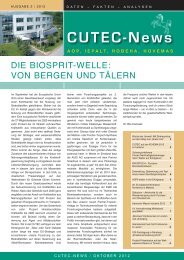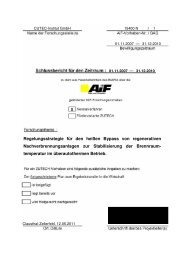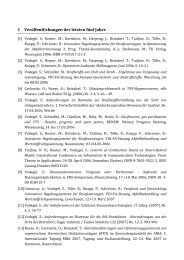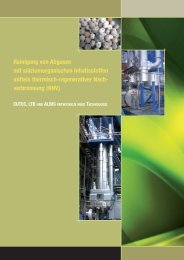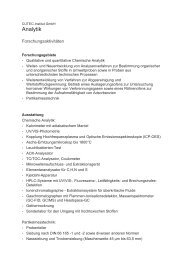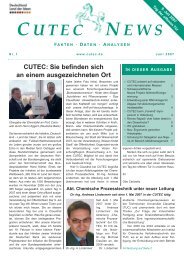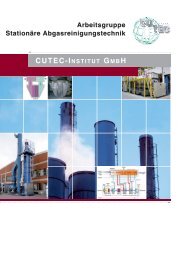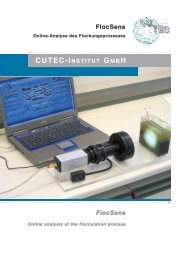CUTEC-News - CUTEC-Institut GmbH
CUTEC-News - CUTEC-Institut GmbH
CUTEC-News - CUTEC-Institut GmbH
Create successful ePaper yourself
Turn your PDF publications into a flip-book with our unique Google optimized e-Paper software.
ISSUE 1 / 2013 D A T A – F A C T S – A N A L Y S I S<br />
GREAT NEWS! <strong>CUTEC</strong> WINS 2012 GERMAN<br />
MINERAL RESOURCE EFFICIENCY AWARD<br />
Group photo showing the award winners and consortium partners at the presentation<br />
ceremony in Berlin.<br />
Everyone involved was exceptionally<br />
pleased when the letter from the German<br />
Mineral Resource Agency came through<br />
the door in the middle of October officially<br />
confirming that the <strong>CUTEC</strong> Sustainability<br />
Management Clusterʼs (CNM) entry for the<br />
2012 German Mineral Resource Award had<br />
earned us a place in the winnerʼs circle.<br />
The big day arrived on November 29 th . At<br />
the conference on efficient use of mineral<br />
resources & success in the marketplace<br />
hosted by the German Ministry of Eco -<br />
nomics in Berlin, State Secretary Dr. Bern -<br />
hard Heitzer presented the 10,000 euro<br />
award to <strong>CUTEC</strong> Managing Director Prof.<br />
Otto Carlowitz and the two project leaders<br />
Dr. Torsten Zeller and Andreas Sauter. The<br />
project partners which included the <strong>Institut</strong>e<br />
of Mineral and Waste Processing, Waste<br />
Disposal and Geomechanics at Clausthal<br />
University of Technology (IFAD), Andritz<br />
Sundwig <strong>GmbH</strong>, Fritz Winter Eisengießerei<br />
<strong>GmbH</strong> & Co. KG, Rohstoff-Handels gesell -<br />
schaft mbH, Xstrata Zink <strong>GmbH</strong> and<br />
Wolfsburg AG were also represented on<br />
stage at the presentation ceremony. The<br />
award gives due recognition to the Zinc<br />
<strong>CUTEC</strong>-<strong>News</strong><br />
S O A M – S A F E W I N D P A R K S<br />
Recovery from Steel Scrap consortium<br />
project for its “outstanding and innovative<br />
contribution to the efficient use of mineral<br />
resources”. <strong>CUTEC</strong> acts as project coordinator.<br />
The project is embedded into the<br />
2020 high-tech strategy put in place by the<br />
Ministry of Education and Research<br />
(BMBF). The three-year project was part of<br />
the “r 2 ” research programme on innovative<br />
technologies to boost resource efficiency in<br />
mineral resource intensive production.<br />
Funding was channelled through the Berlin<br />
office of Project Management Jülich (PTJ).<br />
The Zinc Recovery from Steel Scrap<br />
project focused on a new approach to zinc<br />
recycling in the automotive industry. Large<br />
volumes of galvanised sheet metal scrap<br />
(primary scrap) accumulate in automotive<br />
production. The current recycling process<br />
is to melt the scrap trimmings in electric<br />
furnaces. The zinc vaporises but only a<br />
portion of it can be recovered from the filter<br />
residue. The entire process is also very<br />
energy and resource intensive, and it has a<br />
considerable negative environmental<br />
impact. Compared to the conventional<br />
technique, the new bypass zinc recovery<br />
<strong>CUTEC</strong>-NEWS / JANUARY 2013<br />
process improves energy efficiency by<br />
roughly 75%, reduces CO 2 emissions by<br />
around 80% and significantly increases the<br />
proportion of zinc which is recovered in the<br />
new waste-free recycling process. Due to<br />
the high purity and the presence of hardening<br />
by-elements, the de-zinced steel<br />
sheet can be used as very high-grade<br />
stock in the foundry industry. Sulphuric acid<br />
solution is used to remove the zinc from<br />
scrap on the semi-industrial scale pilot line<br />
which was installed at <strong>CUTEC</strong> in 2010. The<br />
line consists of 5 pickling and washing<br />
baths. It was originally designed with a<br />
nominal throughput capacity of 10 tonnes<br />
per day. Optimisation carried out by IFAD<br />
has now increased that figure to 100<br />
tonnes. Building on the experience gained<br />
during operation of the <strong>CUTEC</strong> line, a car<br />
manufacturer in Lower Saxony is planning<br />
to install an industrial zinc recovery line in<br />
2013. Two international patents have been<br />
granted for the new process used to treat<br />
primary scrap. Due to the presence of paint<br />
coatings and other substances adhering to<br />
the sheet metal such as oil and grease, the<br />
process is not unsuitable, or can be used<br />
only to a very limited extent, to treat<br />
Continued on page 2<br />
CNM* acquires BMBF HOVEMAS<br />
Project 2<br />
Metal expertise – safeguarding the<br />
future 2<br />
Feature article:<br />
SOAM Project: Detection, identification<br />
and classification of contaminated<br />
military dump sites 3<br />
5 th Lower Saxony Fuel Cell<br />
Summer School – a review 4
CNM* ACQUIRES BMBF<br />
The Cluster Sustainability Management<br />
(CNM) has acquired a project entitled<br />
“Innovative Techniques for High-Quality<br />
Recycling of Magnesium Chips” (HOVE -<br />
MAS) from the Federal Ministry of<br />
Education and Research (BMBF). Project<br />
Management Jülich (PTJ) in Berlin is acting<br />
in the administrative liaison role, and<br />
<strong>CUTEC</strong> will be the consortium coordinator.<br />
The <strong>Institut</strong>e of Metallurgy(IMET) at the<br />
Clausthal University of Technology along<br />
with SKW Stahl-Metallurgie Holding AG,<br />
Magrec Recycling <strong>GmbH</strong> and Fritz Winter<br />
Eisengießerei <strong>GmbH</strong> & Co. KG are the<br />
members of the project consortium.<br />
Magnesium is a strategic metal. The<br />
annual worldwide production is approximately<br />
one million tonnes and continues to<br />
increase at a considerable rate. The supply<br />
of magnesium products to the European<br />
machinery manufacturing, automotive and<br />
steel industry is more than 90% dependent<br />
on China. Production is very energy-intensive,<br />
particularly because of the strong<br />
chemical affinity with oxygen and chlorine.<br />
Recycling has now become a very significant<br />
factor. Scrap metal has the advantage<br />
that the energy needed for reduction has<br />
HOVEMAS PROJECT<br />
Process concept for HOVEMAS and need for research (green)<br />
**REWIMET: Lower Saxony strategic industrial metal recycling cluster<br />
already been expended. Energy consumption<br />
during primary production is at least<br />
30-35 kWh/kg of magnesium, causing<br />
substantial CO 2 emissions. In comparison,<br />
far less energy (approx. 1 kWh/kg of<br />
magnesium) is needed to re-melt clean<br />
scrap.<br />
Magnesium alloy chips in the die<br />
casting industry cannot currently be recycled.<br />
In secondary recycling, there is<br />
currently no economically feasible way to<br />
utilise the metal content of magnesium<br />
alloy chips which cannot be returned<br />
directly to the foundry recycling loop.<br />
The overall goal of the project is to<br />
develop techniques to recover magnesium<br />
from magnesium alloy chips.<br />
Two basic usage pathways are envisaged:<br />
1. Use as magnesium granules for pig iron<br />
desulphurisation to meet the requirements<br />
of the iron and steel industry.<br />
2. Return magnesium as a secondary<br />
material to the metal alloy recycling<br />
loop.<br />
The project will provide the first feasible<br />
route for recovering secondary raw materials<br />
which up to this point have not been<br />
returned to the recycling loop. (dm)<br />
2 <strong>CUTEC</strong>-NEWS / JANUARY 2013<br />
Metal expertise – safe-<br />
guarding the future<br />
Stephan Weil, SPD candidate for the<br />
office of Minister President, along with an<br />
SPD delegation paid a visit to the<br />
Clausthal research cluster on October<br />
29 th at the invitation of REWIMET**.<br />
<strong>CUTEC</strong>ʼs contribution to energy and<br />
resource efficiency was given ample<br />
space on the visit itinerary. Weil was<br />
visibly impressed as Prof. Carlowitz<br />
outlined our research activities which<br />
focus on practical application. Real-world<br />
implementation of the research results,<br />
particularly by the Sustainability Mana -<br />
gement Cluster, ensures that the solutions<br />
meet tomorrow's needs. Close<br />
linkages with the regional metallurgy and<br />
metalworking industry along with the<br />
recycling cluster at TU Clausthal in partnership<br />
with REWIMET give the region a<br />
significant advantage as a business location.<br />
Weil emphasised the fact that the<br />
Harz region has more to offer than<br />
attractive natural surroundings and<br />
tourism. He described it as an established<br />
centre of expertise in metals and metal<br />
recycling. Something like 30 strategic<br />
industrial metals are currently being recovered<br />
here. Using this profile as a base,<br />
the task at hand is to take specific action<br />
to enhance regional development. Letʼs<br />
do it! (ze)<br />
Continuation from page 1<br />
GREAT NEWS! …<br />
secondary scrap, for example from car<br />
recycling. Instead, the conventional rolling<br />
process is still the standard technique. The<br />
proportion of primary scrap in total recycled<br />
scrap volumes is currently in the single digit<br />
percentage range. The German Mineral<br />
Resource Efficiency Award sponsored by<br />
the German Ministry of Economics and<br />
Technology in partnership with the German<br />
Mineral Resource Agency gives recognition<br />
to outstanding examples of mineral<br />
resource and material efficient products,<br />
processes, services and/or applicationsorientated<br />
research in the business sector.<br />
Presentation of the Award is intended to<br />
reinforce the importance of mineral<br />
resource and material efficiency in industry<br />
and raise awareness for this vital issue.<br />
The Award was presented to 5 winners for<br />
the first time in 2011. (ze/sr)
Feature article<br />
SOAM PROJECT: DETECTION, IDENTIFICATION AND CLASSI-<br />
FICATION OF CONTAMINATED MILITARY DUMP SITES<br />
Following the passage by roll call vote of<br />
the 13 th revision to the Atomic Power Act in<br />
the German Bundestag on June 30th 2011,<br />
the North Sea and Baltic Sea have now<br />
definitely become part of the industrial<br />
landscape. 42 offshore wind parks with a<br />
peak output of 44 520 MW will soon be<br />
generating renewable energy.<br />
The enormous challenge of building<br />
wind parks on such a massive scale<br />
extends beyond the technological and<br />
engineering aspects.<br />
Conservative estimates indicate that<br />
1 800 000 t of conventional munitions and<br />
230 000 t of chemical munitions have been<br />
dumped over large areas in German waters<br />
alone, and the exact location of the dump<br />
sites remains unknown. In addition to mine<br />
fields which are still in existence, some<br />
areas have been identified as contaminated,<br />
but the assumption has to be made<br />
that hazardous war-related material may be<br />
present in all other areas as well.<br />
The illustration below showing some of the<br />
dump sites gives you an idea of the vast<br />
size of the area where disposal of<br />
unwanted munitions poses an environmental<br />
threat.<br />
So far, locating and recovering the<br />
hazardous material has generally involved<br />
a painstaking effort. In many cases, it has<br />
been necessary to send divers down, in<br />
Dump sites<br />
Areas contaminated with ammunition<br />
Areas potentially contaminated with<br />
Major munitions dump sites in the North Sea and Baltic Sea region<br />
Example of seismic tomography imagery of munitions<br />
which needs to be analysed<br />
best case scenarios following scanning<br />
with towed sensors.<br />
The state of the material retrieved<br />
covers the entire spectrum from “munitions<br />
heavily degraded by corrosion” to “munitions<br />
preserved by shell limestone etc.<br />
which are virtually intact”.<br />
These latter munitions in particular are<br />
fully functional. As a result, before wind<br />
generators can be anchored to the North<br />
Sea and Baltic Sea beds and connected to<br />
land, the affected areas must be decontaminated.<br />
<strong>CUTEC</strong>-NEWS / JANUARY 2013<br />
This being the case, a<br />
consortium made up of WTD*<br />
71, Atlas Elektronik, Hirdes<br />
EOD and <strong>CUTEC</strong> was<br />
formed in October 2011 to<br />
provide a means of automatically<br />
detecting, identifying<br />
and classifying hazardous<br />
submerged waste using the<br />
latest underwater location<br />
technology and autonomous<br />
underwater vehicles. CI**based<br />
methodologies will<br />
have to be developed, tested<br />
and deployed in prototypes.<br />
GPGPU*** development<br />
tech niques using CUDA****<br />
will be used to develop the<br />
high-speed algorithms that<br />
will be needed to handle the enormous<br />
volume of data.<br />
Prof. Matthias Reuter, who is head of<br />
the Modelling and Simulation Department<br />
at <strong>CUTEC</strong>, will act as Coordinator on this<br />
project which is funded by BMWi (Ministry<br />
of Economics and Technology). The project<br />
got underway on October 1 st , 2012. (re)<br />
*WTD = Defence Technology Centre<br />
**CI = Computational Intelligence<br />
***GPGPU = General Purpose Computing on Graphics<br />
Processing Units (GPUs are used in combination with the<br />
CPU to increase the speed of scientific and technical<br />
applications)<br />
****CUDA = Compute Unified Device Architecture which<br />
increases computational speed by making GPUs accessible<br />
for computation.<br />
IMPPRINT<br />
Published by:<br />
<strong>CUTEC</strong>-<strong>Institut</strong> <strong>GmbH</strong><br />
Editor: Dr. T. Heere (he)<br />
Contributors:<br />
Dipl.-Ing. A. Dittmar (dm)<br />
Dipl.-Ing. R.-U. Dietrich (di)<br />
apl. Prof. M. Reuter (re)<br />
Dipl.-Kaufm. A. Sauter (sr)<br />
Dr. T. Zeller (ze)<br />
Layout and typesetting:<br />
G. Wessels (wes)<br />
Production and supply:<br />
<strong>CUTEC</strong>-<strong>Institut</strong> <strong>GmbH</strong><br />
Leibnizstr. 21+23<br />
38678 Clausthal-Zellerfeld<br />
Phone +49 5323 933-0<br />
Fax +49 5323 933-100<br />
E-Mail: cutec@cutec.de<br />
Internet: www.cutec.de<br />
Publication:<br />
Several times a year at irregular<br />
intervals. Issues can be ordered<br />
from the address above at no<br />
charge.<br />
Send an E-mail to:<br />
cutec-news@cutec.de<br />
3
5 TH LOWER SAXONY FUEL CELL SUMMER SCHOOL<br />
– A REVIEW<br />
Students and lecturers in front of the NEXT ENERGY building in Oldenburg<br />
An article published in the Oldenburg<br />
Nordwest-Zeitung entitled “Energy<br />
Transition – Young Researchers Take Up<br />
the Challenge” contained a report on the<br />
Fuel Cell Summer School. During a visit to<br />
the EWE NEXT ENERGY research<br />
centre, journalists from the Delmenhorster<br />
Kreisblatt were able to get a firsthand<br />
impression of the information sharing platform<br />
which offered a broad range of basic<br />
knowledge and information with significant<br />
practical relevance. They were impressed<br />
with the level of enthusiasm shown by the<br />
students and doctoral candidates who<br />
attended this event series which is unique<br />
nationwide and addresses the “great<br />
future challenge of energy supply”, as one<br />
of the attendees put it in a discussion with<br />
the journalists.<br />
<strong>CUTEC</strong> was selected by the Lower<br />
Saxony Ministry of Economics, Labour<br />
and Transport to organise the Summer<br />
School again this year. The students also<br />
had the opportunity to learn more about<br />
NEXT ENERGY, the Lower Saxony<br />
research institution which hosted the<br />
event.<br />
Support was provided by EWE AG,<br />
IAV <strong>GmbH</strong>, H.C. Starck <strong>GmbH</strong> and<br />
Volkswagen AG which are industrial partners<br />
in the State Fuel Cell and<br />
Electromobility Initiative as well as by the<br />
universities in Braunschweig and Claust -<br />
hal and the Wolfsburg campus of Ostfalia<br />
University.<br />
50 students and doctoral candidates<br />
were on hand at the 5th Lower Saxony<br />
Fuel Cell Summer School in Oldenburg<br />
on September 24 th – 28 th . The event was<br />
fully booked weeks in advance. Those<br />
who missed out have been put on a<br />
waiting list for next year. The message is<br />
obviously spreading that the Summer<br />
School offers real quality and a great<br />
atmosphere. The consensus following a<br />
week of lectures, practicals, discussions<br />
and the generation of presentations was<br />
overwhelming and unanimous: "great<br />
credit is due to the organisers and<br />
sponsors, great lectures covering a wide<br />
range of topics, very good mix of information<br />
from the research and industrial<br />
communities.”<br />
Following words of welcome by the<br />
event host Prof. Agert, the representative<br />
of the Lower Saxony Energy Storage and<br />
Systems Initiative, Mr. Bub from innos-<br />
Sperlich and Mr. Dietrich from <strong>CUTEC</strong><br />
which organised the Summer School,<br />
scientists based in the local region<br />
provided an insight into the fundamental<br />
scientific principles involved in fuel cells<br />
and battery technology such as electrochemistry,<br />
thermodynamics, materials,<br />
parts, components and systems.<br />
The list included Prof. Agert and<br />
Dr. Dyck from NEXT ENERGY, Prof.<br />
Wittstock from the University of<br />
Oldenburg (C-v-O), Prof. Krewer and Mr.<br />
Haselrieder from TU Braunschweig, Dr.<br />
Dörrer, Prof. Wenzl, Prof. Kunz and Prof.<br />
Turek from TU Clausthal and Dr.<br />
Lindermeir from <strong>CUTEC</strong>. Prof. Lehnhoff<br />
from the University of Oldenburg and Dr.<br />
Hermsmeier from EWE AG gave presentations<br />
outlining the conclusions which<br />
must inevitably be drawn from Germanyʼs<br />
energy transition policies.<br />
4 <strong>CUTEC</strong>-NEWS / JANUARY 2013<br />
Dr. Arndt, EWE AG, Mr. Zobel, NEXT<br />
ENERGY, Dr. Otterstedt, H.C. Starck<br />
<strong>GmbH</strong>, Mr. Meinel, I+ME Actia <strong>GmbH</strong>, Dr.<br />
Antonius, Johnson Controls, Dr. Arendt,<br />
Dr. Kleppa and Dr. Hofmann from<br />
Volkswagen AG and Dr. Hickmann, W.<br />
Eisenhuth <strong>GmbH</strong>, shared information on<br />
applications and existing problem areas.<br />
Experts based in Bavaria (Dr. Hofmann,<br />
Siemens AG), North Rhine-Westphalia<br />
(Mr. Lohren, Ceramic Fuel Cells),<br />
Mecklenburg-Vorpommern (Dr. Boltze,<br />
new enerday) and Saxony (Mr. Strohbach,<br />
Staxera <strong>GmbH</strong>) also gave talks.<br />
Summer School students worked in teams<br />
to solve complex tasks<br />
Practical exercises gave the scientists<br />
from Lower Saxony a good opportunity to<br />
familiarise the Summer School students<br />
with the subject matter. <strong>CUTEC</strong> organised<br />
a hands-on fuel cell workshop. NEXT<br />
ENERGY provided helpful support at the<br />
hands-on battery workshop which had<br />
been originally designed and organised<br />
for last yearʼs Summer School by the<br />
<strong>Institut</strong>e for Chemical Process Engi -<br />
neering. There was also an excursion to<br />
the EWE FutureCentre at the Emstek<br />
Ecopark, which provided the opportunity<br />
to witness a demonstration of how fuel<br />
cells might be used in detached houses of<br />
the future and also to explore the capabilities<br />
of Electromobility.<br />
After a week filled with the basic scientific<br />
fundamentals, current research results<br />
and highly interesting hands-on experience,<br />
the course participants were in a better<br />
position to decide whether they might want<br />
to specialise in fuel cell and battery technology<br />
in the future. Lower Saxony is<br />
leading the way by giving young members<br />
of the academic community a greater<br />
insight into technology which will play a<br />
major role in the energy transition and by<br />
providing a platform for sharing information<br />
with the world of science and industry. (di)




